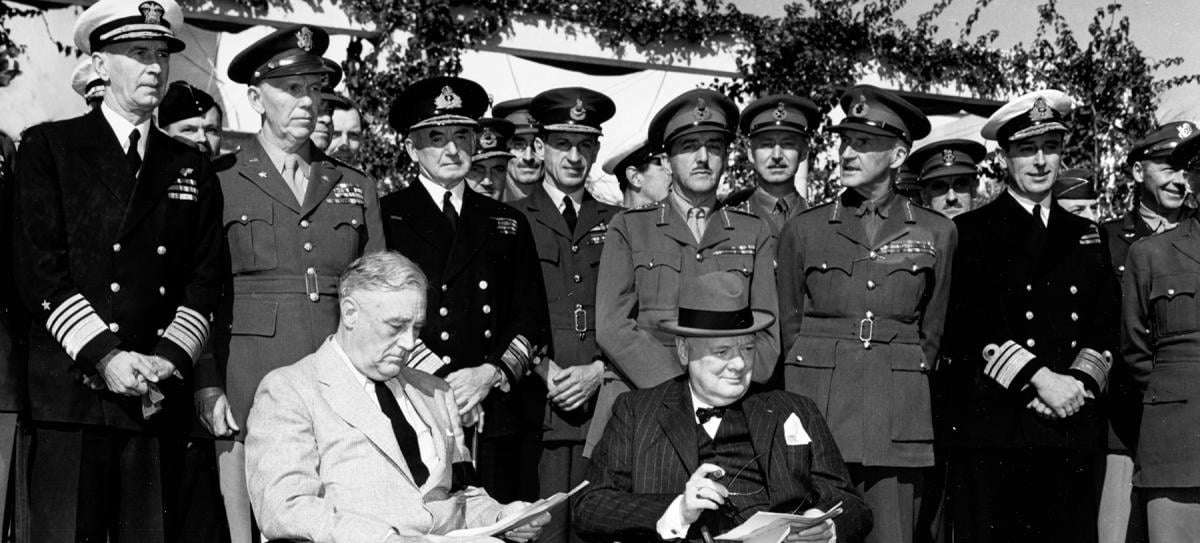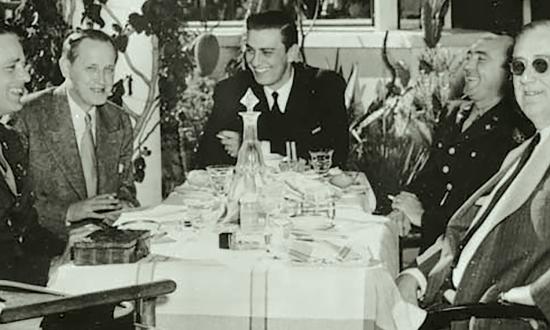The 2022 National Defense Strategy proclaimed “mutually-beneficial Alliances and partnerships are our greatest global strategic advantage.”1 The rising power of China has made this a truism. But if any future coalition against Chinese aggression is to be successful without over-extending its naval power, the U.S. and its allies must find a way to overcome the quagmire of similar alliances throughout history: how to forge a cohesive and realistic strategy. The Casablanca Conference of January 1943 between U.S. President Franklin Roosevelt, British Prime Minister Churchill, and their Combined Chiefs of Staff (CCS) provides a blueprint for how to accomplish this.
The conference at Casablanca was not unique, but it was pivotal to the formation of the Allied strategy because it occurred at the start of 1943. Historian Paul Kennedy described 1943 as the “critical year.”2 The doubling of U.S. warship tonnage and similar feats of production enabled operations that were unthinkable the year before.3 Yet the massive fleets of 1945 were still under construction. Thus, the operational possibilities were numerous but not endless. The CCS had to make potentially contentious decisions as to where to employ their finite resources. As with any alliance, this challenge was exacerbated by the partners’ diverging strategic priorities.
Since the Blitz in 1940, British power had relied, in Churchill's immortal words, on her “Empire beyond the seas, armed and guarded by the British Fleet.”4 A poignant example of this reliance was that Britain trained more than 75,000 pilots, crucial to the Battle of Britain, in flight schools throughout the empire.5 This made the links to that empire a paramount British strategic concern.
In contrast, the American planners had easy access to their nation’s war-making potential. Instead, they fretted how to bring it into battle before the Axis powers could consolidate their gains and make counter-invasion prohibitively expensive. The Joint Chiefs of Staff (JCS) were not monolithic in their particular priorities, but they all believed the maritime advantage enjoyed by the Allies had to be used to strike meaningful blows against both the Germans and Japanese in 1943.
It is surprising, therefore, that the Casablanca Conference receives little attention in most analyses of Allied strategy. When it is discussed, the pervasive theme is that the British dominated the conference’s outcome to the detriment of Allied strategy. Such narratives reach this conclusion by over-relying on postwar interviews in which the subjects often inflate their influence and entertain alternate histories. Necessarily, this inflates disagreements and downplays the value of the CCS as a whole.
A close examination of the meeting minutes and the conference’s outcome, particularly in regard to Allied planning for the South Pacific, the Mediterranean, and Northern Europe, provides a better understanding. The outcome of the conference was a compromise between both powers’ legitimate strategic priorities that nonetheless prudently employed limited Allied resources to simultaneously protect British imperial links and maximize pressure on all the Axis powers. This was a massively important accomplishment unmatched in similar historic alliances.
Thus, understanding the conference’s achievements also highlights the unique ability of the CCS as a working group to achieve a pragmatic compromise. And so, Casablanca serves as an important lesson in, not only what an effective allied strategy looks like, but also how it can be achieved. That lesson is crucial for contemporary U.S. planners once again contemplating a great-power war.
Interpreting ‘Germany First’
“Germany First,” the principle whereby the Allies would concentrate on the defeat of Germany before turning to the Pacific, had been agreed to in 1941, and neither Roosevelt nor Churchill were inclined to renegotiate it. However, that general principle left significant room for interpretation since it did not specify what portion of Allied resources would actually be employed in the Pacific, nor whether those forces would be used for offensive operations. So far, the effectiveness of the Japanese onslaught in 1941–42 had obviated the need to reach a consensus on these questions. The Allies could not reasonably ignore the Japanese offensive that simultaneously threatened the British Imperial power base of India and the American hold on the Central and Eastern Pacific. But by 1943, the Japanese losses at Guadalcanal and the newfound resources available to the Allies meant they would have to agree on what the “Germany First” principle actually meant in practice.
The U.S. Army Chief of Staff General George Marshall and Chief of Naval Operations Admiral Ernest King dramatically opened the discussions by proposing the “broad allocation” of Allied resources in the Pacific be increased from 15 to 30 percent, making clear the U.S. position.6 Sir Alan Brooke, Chief of the Imperial General Staff, immediately laid out the British position by questioning whether further resources were required since it appeared to him the Japanese were now on the defensive.7
It is remarkable the degree to which the final agreements from Casablanca reflected the American position on the Pacific. CCS Memorandum 155/1 stated that operations would be continued “with the object of maintaining pressure on Japan, retaining the initiative and attaining a position of readiness for the full scale offensive against Japan.” More specifically, it authorized not only the capture of Rabaul, but also Pacific Fleet Commander-in-Chief Admiral Chester Nimitz’s campaign through the Central Pacific that would eventually win the war. The only stipulation was that the allocation of forces there could not preclude capitalizing on “any favorable opportunity that may present itself for the decisive defeat of Germany.”8
More important than the fact that the JCS got its way, is that the decision to allocate resources for Pacific offensives in 1943 was a prudent one. The Japanese were unlikely to passively wait if the Allies adopted the British proposal and paused Pacific offensives. As Marshall argued, “short of offensive action . . . the only way of stopping the Japanese was by complete exhaustion through attrition” later in the war.9 Nimitz’s and General Douglas MacArthur’s offensives limited Japanese agency and forced them to react to U.S. moves for all of 1943. Additionally, the earlier-than-expected assaults on Rabaul and the Marshalls prevented the Japanese from fortifying those locations to the same extent they had in the Gilberts or later at Iwo Jima.10
Attacking Europe’s Underbelly
It is easy to write off the Mediterranean Theater in 1943 as a strategic backwater given the relative size of the Axis armies employed there compared to the Eastern Front. Nevertheless, it was a major British concern. As was discussed above, Britain’s strategy was largely focused on securing the links to her empire, and no imperial link had come under more strain than that from Alexandria to Gibraltar. The impending eviction of German and Italian troops from North Africa partially alleviated the stress, but, after the battle for Malta, the Royal Navy understood the threat posed by German airfields in Sicily and Southern Italy. At Casablanca, First Sea Lord Admiral Dudley Pound stressed this point, stating that the capture of Sicily or Sardinia would reduce shipping losses through the Mediterranean by 50 percent and facilitate sending Middle Eastern oil to the British fleet at Gibraltar vice the American oil supplies needed in Britain.11
The American planners were not surprised by British arguments for further moves in the Mediterranean. They had already discussed the strategic possibilities with the President before the conference on 7 January, where both Marshall and King enumerated possible benefits of such a strategy including Pound’s arguments.12 The JCS were by no means fully sold on the idea by that point, but their understanding of why the British were inclined toward Sicily or Sardinia directly contradicts the narrative that the JCS were either strong-armed or hoodwinked at the conference into the invasion of Sicily (Operation Husky).
The JCS, armed with their understanding of the British interests and willing to compromise for a cohesive strategy, focused the scope of operations. Brooke, at the behest of Churchill, had originally floated “Sardinia, Sicily, Crete, and the Dodecanese” as options, but the JCS understood the limits of what could be accomplished.13 They focused the conversation toward Sicily, which met their strategic priority of applying the maximum pressure on Axis continental power, and away from strategically whimsical designs farther to the East. Marshall was therefore correct that, without the JCS at the conference, the Allies “would have been lost in the Balkans.”14
Deferring Normandy
Since the first talks in 1941, Allied strategy envisioned a large cross-channel invasion to reopen the front in France (Operation Roundup). But the operational concept was not fully developed, and that had opened the door to negotiation as to when the invasion would occur and what it would look like. Marshall and King had lobbied (and failed) to adopt a smaller operation in 1942, to seize and hold only the Cherbourg Peninsula (Operation Sledgehammer), which would seem to imply that the JCS similarly arrived at Casablanca committed to a cross-channel invasion in 1943. However, the preference for Sledgehammer in 1942 does not mean that the JCS were fully committed to Roundup in 1943.
Brooke made the British position clear when he posed the choice of an invasion of Northern France in September or continuing operations in the Mediterranean earlier in the summer.15 Since the British Chiefs had already expressed their views on the potential for Mediterranean operations, their preference was not a secret. Contrary to what is told by most historians, the meeting minutes make it clear the JCS was not fully opposed to the British position. They initially registered only token objections to the British plan for Sicily in the first meetings on the topic. Then, in a meeting between Roosevelt and the JCS on 16 January, King directly told the President that it was unlikely Roundup could be undertaken before 1944. Marshall too stated that the “JCS had come to the conclusion that Operation Husky should be undertaken.”16 That Marshall and King had reached this conclusion on only the third day of the conference highlights the JCS had come to Casablanca knowing Roundup was likely to be postponed. It also shows that, while both sides still envisioned an eventual cross-channel invasion, neither ally was willing to prioritize that effort over their other strategic requirements in 1943.
The danger to Allied planning lay not so much in arguing over which route to take into Europe, but how to fit a return to the continent into an effective global strategy in a way that satisfied both Allies’ priorities. Marshall highlighted this during the debate on the 17th when he challenged his counterparts to envision how the proposed future operations would fit into the Allies “overall strategic plan.”17 Some postwar observers argued that the strategy reached at Casablanca failed to do this because it did not take more pressure off the Russian Army in 1943. But, as Brooke pointed out, British and American ground forces were simply not sufficient to take any pressure off the Russians at that time.18 Husky was therefore a compromise that would allow the Allies to utilize their amphibious and air resources to exert maximum pressure on the Axis, while also minimizing shipping losses. More to the point, the choice made was practical given the resources available, and it maintained Allied cohesion.
Bucking the Historical Trend of Maritime Alliances
The success of the CCS in reaching a cohesive and reasonable strategy is all the more remarkable when compared to the historical record of similar alliances. Most alliances confronted with a similar challenge either overextend themselves or simply disintegrate due to differing strategic conceptions. This trend is more acute for maritime-based alliances because the vast and fluid battlespaces in naval warfare make for more operational possibilities that are less likely to be mutually supportive.
The Italian and German alliance in 1940–42 is a classic example of overextension. Whereas the Germans desired a small commitment of their air power to sever British links through the Mediterranean from Italian bases, Benito Mussolini wanted to extend his new “Roman Empire” into British North African possessions. By choosing to do both and also invade Russia, the Axis powers overextended themselves and had to prioritize shipping through the “Maltese gauntlet” over much-needed Caucasian oil.19 The German and Italian high commands never met to discuss strategy lest they bypass the decision-making power of their dictators. Perhaps they would not have made this mistake if they had.
More often, coalitions simply disintegrate when strategic differences are encountered, as the Venetian, Papal, and Habsburg Holy League Alliance did after the Battle of Lepanto in 1571. The Ottoman attack on the Venetian possession of Cyprus posed a clear enough threat to the Habsburg Empire in the Western Mediterranean and ignited Pope Pius V’s thirst to revamp the Crusades. These powers had agreed to joint tactical command of the Holy League fleet under Don John to deal with the acute threat of the Ottoman fleet at Cyprus but did not pursue a combined strategy. Joint tactical command only produced tactical success at Lepanto, not strategic cohesion. Thus, even in victory, the Holy league did little to enhance the strategic position of any of the three allies, and the Ottomans retained a strong position threatening every Christian state in the Mediterranean.20
The Conference Dynamic as Key to Success
Any of the discussions surrounding the operational possibilities in the Pacific, Mediterranean, and Northern France could have caused the Anglo-American alliance to falter like the Holy League. Offensives in all three theaters simultaneously would have risked a comparable overextension of maritime resources to that of the Axis in 1941. That neither occurred is due to the unique dynamic of the CCS on display at Casablanca.
A powerful example of the crucial role played by the CCS was Churchill’s proposal at Casablanca to revive the Sledgehammer operation in 1943 in addition to Husky.21 Roosevelt, despite having already discussed the impossibility of this scheme with the JCS, agreed. It is conceivable that had Churchill and Roosevelt set strategy alone they might have embarked on just such a plan as a means to show progress both at home and to the Soviet Union. However, Marshall echoed a realization made by the CCS days before and told the two leaders it would be “difficult if not impossible” to undertake both Husky and Sledgehammer in 1943 due to the conflicting demands they would put on shipping and landing craft.22 In doing so, Marshall proved the value senior military leaders can provide to their political masters to prevent strategic overextension.
This is not to say that the two leaders were unimportant or counterproductive in forging a cohesive grand strategy. To the contrary, Roosevelt and Churchill were crucial in two ways. First, they imposed unity on their sometimes unwilling military advisers. Prior to the North African campaign, King and Marshall tried to threaten an Allied rupture if the U.S. position was not followed. But they were rebuffed by the President. That similar threats were not made by either side at Casablanca was certainly due to the leaders’ presence. Second, the leaders trusted their chiefs to conduct inter-allied discussions with limited supervision. The leaders were present at only three of the 18 meetings between the CCS at Casablanca.23 As shown by the leaders’ short-lived discussion of Sledgehammer in 1943, this trust ensured a pragmatic strategy.
A Model for Current U.S. Indo-Pacific Alliances
Current national-security thinking on the Pacific recognizes the obvious benefits of alliances in any potential conflict. But the United States and its allies must beware of the pitfalls that threaten any alliance and acknowledge how they can overcome them. Multinational command structures like NATO and the push to deepen “interoperability” with allied forces will be crucial in a future war.24 But the decisions made at Casablanca could not have been made by the theater commanders or even a single Supreme Allied Commander directly responsible to the heads of state. Any single commander who is responsible to two (or more) diverging sets of strategic priorities with limited means will find the job impossible. Like Don John after Lepanto, they will watch their forces splinter to pursue separate objectives.
On the other hand, as shown by the Casablanca deliberations, a working group like the CCS can prudently bridge the strategic divide. Therefore, in any potential conflict, the U.S. should construct a similar institution with our allies. The meeting between General Mark Milley, Chairman of the Joint Chiefs of Staff, with his Japanese counterpart, General Kōji Yamazaki, “to discuss Japan’s National Security Strategy” and similar such meetings are an important step in this direction.25
But the true challenge will be after a potential conflict breaks out and such informal meetings will not be sufficient. Previous arrangements will not survive their first encounter with the enemy, and they may no longer satisfy the current set of strategic priorities. Frequent meetings of high-level military leaders supervised by their political leaders will be necessary to provide flexibility and ensure that follow-on decisions do not overextend limited resources. The President and the Secretary of Defense must have the same confidence in their military leaders that Roosevelt and Churchill did in the CCS and allow them to take the lead in negotiating a realistic strategy. For their part, the JCS, like their predecessors, will have to understand and accommodate their allies’ priorities but never let diplomacy trump realism. Only in this way can America and its allies hope to win the next war.
1. U.S. Department of Defense, “U.S. National Defense Strategy,” https://www.defense.gov/National-Defense-Strategy/.
2. Paul Kennedy, Victory at Sea (New Haven, CT: Yale University Press 2022), 239.
3. Kennedy, Victory at Sea, 299.
4. Winston Churchill, Speech to the House of Commons, 4 June 1940, International Churchill Society, https://winstonchurchill.org/resources/speeches/1940-the-finest-hour/we-shall-fight-on-the-beaches/.
5. Ashley Jackson, The British Empire and the Second World War (New York: Hambledon Continuum, 2006), 39.
6. Fredrick Aandahl, William M. Franklin, and William Slany, eds., Foreign Relations of the United States, The Conferences at Washington, 1941–1942, and Casablanca, 1943 (Washington DC: U.S. Government Printing Office, 1958), 536.
7. Aandahl et al., Foreign Relations, 537.
8. Aandahl et al., 761.
9. Aandahl et al., 533.
10. Ian Toll, The Conquering Tide: War in the Pacific Islands 1942–1945 (New York: W. W. Norton and Co., 2015).
11. Aandahl et al., 631, 585.
12. Aandahl et al., 509.
13. Aandahl et al., 570.
14. The Marshall Foundation, Mary Louise Spilman, ed., “Interview Notes October 5, 1956,” https://www.marshallfoundation.org/wp-content/uploads/2014/05/Interview_10-05-56.pdf, 590.
15. Aandahl et al., 570.
16. Aandahl et al., 597.
17. Aandahl et al., 583.
18. Aandahl et al., 584.
19. Douglas Porch, The Path to Victory: The Mediterranean Theater in World War II (New York: Farrar, Straus, and Giroux, 2004), 7.
20. Roger Crowley, Empires of the Sea: The Siege of Malta, the Battle of Lepanto, and the Conflict for the Center of the World (New York: Random House, 2008).
21. Crowley, Empires of the Sea, 629.
22. Crowley, 631.
23. Crowley, 486–7.
24. U.S. Department of Defense.
25. Office of the Chairman of the Joint Chiefs of Staff Public Affairs, “Readout of Chairman of the Joint Chiefs of Staff Gen. Mark A. Milley’s Meeting with Japan Chief of Staff, Joint Staff Gen. Kōji Yamazaki,” 12 January 2023, https://www.jcs.mil/Media/News/News-Display/Article/3269358/readout-of-chairman-of-the-joint-chiefs-of-staff-gen-mark-a-milleys-meeting-wit/.






